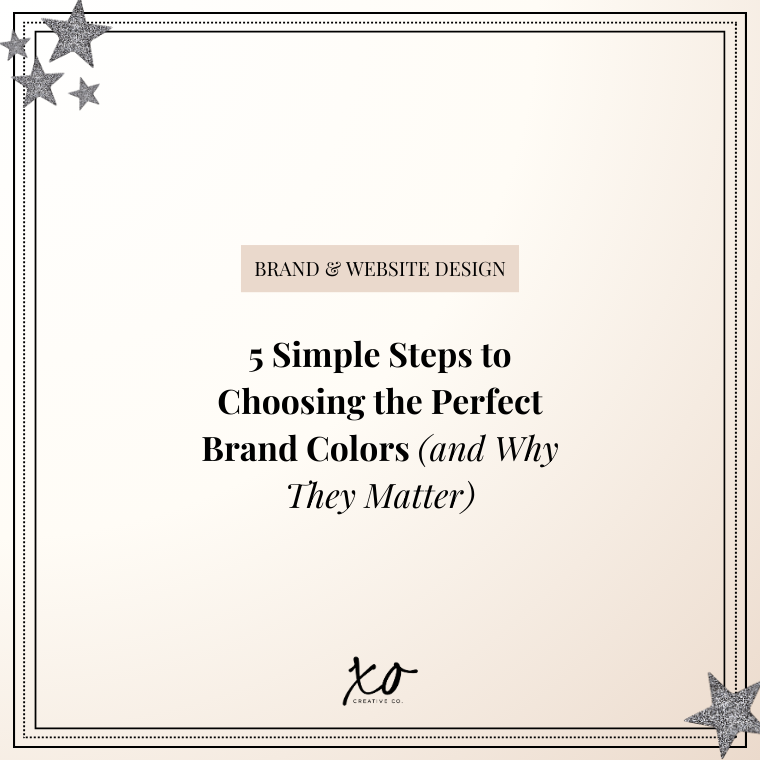5 Simple Steps to Choosing the Perfect Brand Colors (and Why They Matter)
When it comes to building a brand that stands out, color isn’t just an afterthought—it’s a game-changer. The right colors can make your brand instantly recognizable, evoke the right emotions in your audience, and create a cohesive brand identity that speaks directly to your ideal clients.
For female entrepreneurs looking to build a brand that feels authentic and intentional, choosing the right color palette is a crucial step.
In this guide, we’re breaking down everything you need to know about picking the perfect colors for your brand—and why it matters.
Why Brand Colors Matter
Brand colors are more than just a pretty aesthetic. They communicate your brand’s personality, influence consumer perceptions, and help create consistency across all platforms. Here’s why they’re essential:
First Impressions Count – Studies show that people form an opinion about a brand within 90 seconds, and up to 90% of that opinion is based on color alone.
Brand Recognition – Consistent use of color can increase brand recognition by up to 80%, making it easier for people to remember your business.
Emotional Connection – Colors evoke emotions, and the right palette helps you connect with your audience on a deeper level.
Professionalism & Trust – A well-thought-out color scheme makes your brand look polished and professional, which builds trust with potential clients.
Understanding Color Psychology
Before you start picking colors, it’s important to understand color psychology—the study of how colors affect emotions and behaviors. Here’s a quick breakdown of common color meanings:
Red – Passion, energy, excitement (great for bold, attention-grabbing brands)
Orange – Creativity, enthusiasm, friendliness (perfect for approachable, fun brands)
Yellow – Optimism, happiness, warmth (ideal for brands that want to radiate positivity)
Green – Growth, harmony, stability (used in wellness, finance, and eco-friendly brands)
Blue – Trust, professionalism, calmness (popular for corporate and service-based businesses)
Purple – Luxury, creativity, wisdom (often used in beauty, wellness, and artistic brands)
Pink – Feminine, playful, romantic (a go-to for branding for female entrepreneurs)
Black – Elegance, sophistication, power (common in luxury and high-end brands)
White – Clean, minimal, pure (used for modern, fresh branding)
Steps to Choosing the Right Colors for Your Brand
Step 1: Define Your Brand Personality
Your brand colors should reflect your business’s personality. Ask yourself:
What three words describe my brand?
How do I want my audience to feel when they interact with my brand?
What kind of businesses and aesthetics do I admire?
For example, if you’re a small business owner in the wellness space, you might want calming blues and greens. If you’re a female entrepreneur in the fashion industry, you might lean toward bold pinks and purples.
Step 2: Know Your Target Audience
Understanding your audience’s preferences is key to choosing colors that resonate with them. Think about:
What colors attract your ideal client?
Are there industry trends in color usage?
What emotions do you want your brand to evoke?
If your audience is young and fun, bright and playful colors might be the way to go. If your brand is all about professionalism and trust, a more muted or neutral palette may work best.
Step 3: Research Competitor Brands
While you want to stand out, it’s helpful to analyze competitors in your industry. This gives insight into what works and helps ensure your color choices differentiate you while still feeling relevant.
Step 4: Build a Balanced Color Palette
A cohesive brand color palette typically consists of:
Primary Color – The main color associated with your brand.
Secondary Colors – Complementary shades that support the primary color.
Neutral Colors – Background and text colors that provide balance.
For example, a logo design for small businesses might feature a strong primary color (like deep teal), supported by a secondary color (like blush pink) and neutral tones (like warm beige or white).
Step 5: Test Your Colors Across Different Mediums
Before finalizing your palette, test how it looks across different platforms—website, social media, business cards, and packaging. This ensures consistency and versatility.
Tools to Help You Choose Your Brand Colors
If you need help finding the perfect color palette, here are some great tools:
Coolors – A quick and easy color palette generator
Adobe Color – Helps you explore color harmonies
Canva Color Palette Generator – Allows you to upload an image and extract colors
Pinterest – Great for creating mood boards and finding inspiration
Final Thoughts
Choosing the right colors for your brand is about more than just aesthetics—it’s about creating a cohesive brand identity that connects with your audience, represents your business authentically, and helps you stand out. Whether you’re rebranding or starting fresh, take the time to select a palette that aligns with your business’s mission and values.
Still feeling stuck? XO Creative Co. is here to help! As a branding expert specializing in logo design for small businesses and branding for female entrepreneurs, I’d love to help you build a brand that truly feels like YOU.
Let’s chat and bring your brand vision to life!

